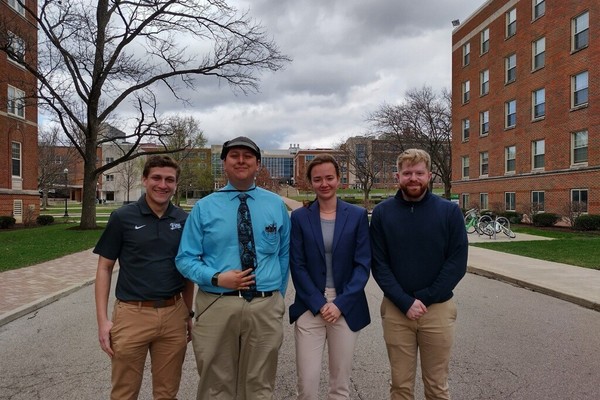
DAYTON, OH - A team of five Trine University seniors majoring in mechanical engineering placed second in the team category at the American Institute of Aeronautics and Astronautics (AIAA) Region III Student Conference with their high-powered rocket design.
The conference was held March 25 at the University of Dayton in Dayton, Ohio.
Ismar Chew of Indianapolis, Myles Taylor of Griffith, Indiana, Makena Thompson of Anchorage, Alaska, Elle Trine of Kokomo, Indiana, and Michael Worosz of Griffith, Indiana, presented their design in a paper titled, "Methods for Modeling and Controlling the Flight Path of a High-Power Rocket."
Using multiple methods to simulate rocket performance, the team developed different nose designs and an aerobraking system to help high-powered rockets reach a pre-determined apogee, or highest point of altitude, no matter the weather conditions or wind speed. The team's goal was to develop a design to control the apogee of the rocket to within 4% of 4,500 feet.
"The judges were clearly impressed by the two methods for controlling apogee that the students have worked hard to design, build and test," said Jamie Canino, Ph.D., faculty advisor.
This is the second year in a row Trine has placed in the team category at the regional event.
Chew also presented a paper separately on "Reducing Dendrite Formation of Sodium Azide Crystals for Nano-Satellite Applications," based on a research experience for undergraduates he completed in the summer of 2022. That project focused on a propulsion material for a type of nano-satellite that is traditionally a 10-centimeter cube, and the tendency of the material to grow offshoots that can damage electronics in the satellite.
(05-08-2025) • Former DeKalb County Sheriff Don Lauer Passes Away
(05-08-2025) • Town Council Hires Company For Paving Projects
(05-07-2025) • Central Noble Voters Say No To Referendum
(05-07-2025) • Hamilton School Voters Approve Referendum Renewal
(05-07-2025) • Bronson Schools Bond Request Voted Down
(05-06-2025) • Indiana Toll Road Upgrades Starting This Week In Elkhart County
(05-05-2025) • 2025 Summer Job Market Forecast Released For Michigan Teens
(05-03-2025) • Trine Breaks Ground For New Student Design Center
(05-03-2025) • Two Coldwater Residents Injured In Accident
(05-03-2025) • Tekonsha Woman Arrested For Child Abuse
(05-03-2025) • Bronson Man Arrested On CSC Charges
(05-02-2025) • WBET And WLKM Win 2025 Liberty Bell Award
(05-03-2025) • Traffic Stop Leads To Arrest Of Michigan Man
(05-03-2025) • Bronson Man Injured In SUV v Semi Accident
(05-01-2025) • Wortz Says Return Control Over Wind, Solar Projects To the People
(05-01-2025) • Second Suspect Arrested In Connection With Fraud Investigation
(04-30-2025) • Westview Schools Name Valedictorian, Co-Salutatorians
(04-30-2025) • Hamilton School Voters To Decide On Referendum On May 6
(04-30-2025) • Wolcottville Man Sentenced For Kidnap And Rape
(04-29-2025) • LaGrange Hometown Hero Banner Program Underway For 2025-2026
